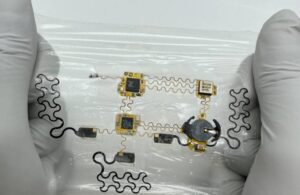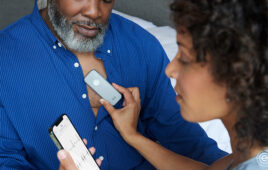
The e-tattoo for monitoring heart health [Image courtesy of the University of Texas]
The ultrathin, lightweight “e-tattoo” attaches to the chest for continuous, mobile heart monitoring outside of a clinical setting. It features two sensors that combine to provide a clear picture of heart health. Researchers developed it in an effort to give clinicians a better chance to catch early red flags for heart disease.
The Texas team published their study in Advanced Electronic Materials.
“Most heart conditions are not very obvious. The damage is being done in the background and we don’t even know it,” Nanshu Lu, a professor in the Department of Aerospace and Engineering Mechanics and a lead author of the study, said in a post on the UT website. “If we can have continuous, mobile monitoring at home, then we can do early diagnosis and treatment, and if that can be done, 80% of heart disease can be prevented.”
About the e-tattoo
The latest development by this team marks a continuation of an earlier chest-based e-tattoo project. However, this technology is wireless and mobile, thanks to small active circuits and sensors linked by stretchable interconnections. The clear device conforms to the chest via medical dressing and offers less intrusiveness than other monitoring systems. Researchers also say it’s more comfortable for patients.
According to the team, the e-tattoo only weighs 2.5 grams and runs on a battery the size of a U.S. penny. The battery lasts longer than 40 hours and enables charging options for the user.
The e-tattoo provides electrocardiogram (ECG) measurements and seismocardiogram (SCG) measurements as well. Monitoring these factors can help to measure cardiac time intervals — a major indicator of heart disease and other problems.
“Those two measurements, electrical and mechanical, together can provide a much more comprehensive and complete picture of what’s happening with the heart,” Lu said. “There are many more heart characteristics that could be extracted out of the two synchronously measured signals in a noninvasive manner.”
The research team tested their device on five healthy patients in their day-to-day environments. It produced a low error rate in measurements compared with currently available monitoring options. They say the next step involves more testing and validating the initial results of the e-tattoo. Then, they aim to expand to different types of patients.




